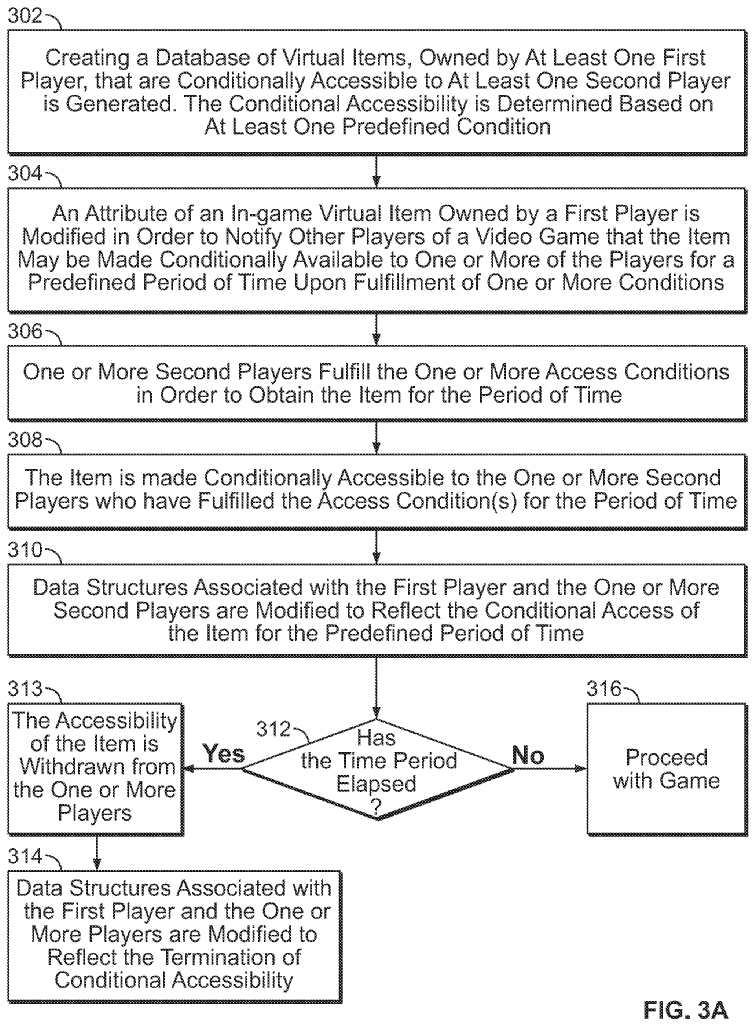Rundown:
- Activision Publishing has recently patented a system for conditional access to virtual gaming items, allowing players to temporarily share items with others based on predefined conditions.
- The patent leverages blockchain technology to store and secure conditions for accessing virtual items, addressing challenges in the gaming industry such as underutilisation of rare items and lack of transparency in transactions.
- The system introduces dynamic gameplay by allowing players to conditionally share items for a limited time, adding unpredictability and excitement to virtual interactions.
- Players have the ability to set conditions for sharing their virtual items, promoting a player-centric approach that empowers individuals to control and tailor their sharing preferences.
- The patent incorporates user-friendly graphical interfaces, notifications, and player consent features to enhance transparency, accessibility, and community engagement in the collaborative gaming experience.
Today, we encountered a newly released patent from Activision Publishing titled “System and Method for Providing Conditional Access to Virtual Gaming Items,” filed in July. Published earlier this week, the patent outlines a system enabling a player in a video game to temporarily share a virtual item they possess with another player, subject to specific conditions.
“The present specification describes a system and method for providing conditional access to a virtual gaming item possessed by a first player of a video game to a second player. The method includes: creating a database of conditionally accessible virtual items, wherein said accessibility is determined based on at least one predefined condition; modifying an attribute of the virtual item for making the second player aware that said item is available for conditional access for a predefined period of time; fulfilling, by the second player, at least one access condition; and providing accessibility to the item to the second player for the predefined period of time,” reads the patent’s abstract.
The patent’s core revolves around storing conditions that must be met for a second player to access a virtual gaming item owned by a first player. These conditions, such as reaching a specific gaming level or transferring virtual currency, are stored in a blockchain, ensuring the integrity and security of the sharing process.
Activision Publishing seeks to address key challenges in the gaming industry, primarily centred around the underutilisation of rare virtual items, limited interactivity between players, and the lack of transparency in virtual transactions.
By introducing a system that utilises blockchain technology, the patent aims to create a secure and traceable record of virtual item sharing, mitigating concerns related to fraud and unauthorized transactions.
Additionally, the patent tackles issues of static gaming experiences by enabling players to conditionally share items for a limited time, introducing a dynamic element that adds unpredictability and excitement to gameplay.
Activision Publishing’s method employs servers to monitor data generated during the execution of the video game, determining whether the predefined conditions are met by the second player. Once conditions are fulfilled, temporary access is granted to the second player, and this access information is recorded on a blockchain ledger.
After a set period, access is returned to the first player, and the second player is denied further access, completing the cycle of temporary sharing. This systematic approach adds a layer of dynamism to virtual item interactions, creating a time-limited collaborative experience within the gaming community.

One notable aspect of the patent is that it allows the first player to set the conditions for sharing their virtual item. This player-centric approach empowers individuals to tailor their sharing preferences, fostering a sense of ownership and control over their virtual assets.
The patent also introduces graphical user interfaces (GUIs) as a means of interaction between players. These interfaces prompt the first player to input conditions, attributes, and details of the virtual item-sharing process. This user-friendly approach ensures that the sharing mechanism is accessible and intuitive, contributing to a seamless gaming experience.

Acknowledging the importance of communication, the patent includes features such as notifications to inform the first player when their virtual item is being shared with a second player. This transparency ensures that players are aware of the sharing process and can actively participate in the collaborative gaming experience.
Moreover, the patent incorporates player consent into the process. The first player is prompted to provide consent for sharing the virtual item with the second player. This additional layer of player involvement reinforces a sense of community and cooperation among players.
This patent aligns with Activision Publishing’s broader vision of transforming gaming interactions beyond traditional gameplay. By introducing a controlled and time-limited sharing mechanism for virtual items, the company aims to enhance the social and collaborative aspects of gaming.
Although the patent appears intriguing, it’s crucial to note that its publication doesn’t assure implementation or ongoing development. The manner in which the company plans to integrate this patented system into its current and future video game franchises remains uncertain, and only time will reveal the specifics.
What do you think about this? Do tell us your opinions in the comments below!
Similar Reads: Activision Working On Self-Learning Lifelike NPCs In Games
Yes
No
Good job! Please give your positive feedback ☺️
How could we improve this post? Please Help us. 🤔
Submit
Started out penning short stories in my room, then stumbled upon my real passion for video game and technology journalism. Now, I’m all about playing and writing about them. With experience from VeryAliGaming, eXputer.com, and TheNerdMag, I’m currently dishing out news on Gamesual from my place.














